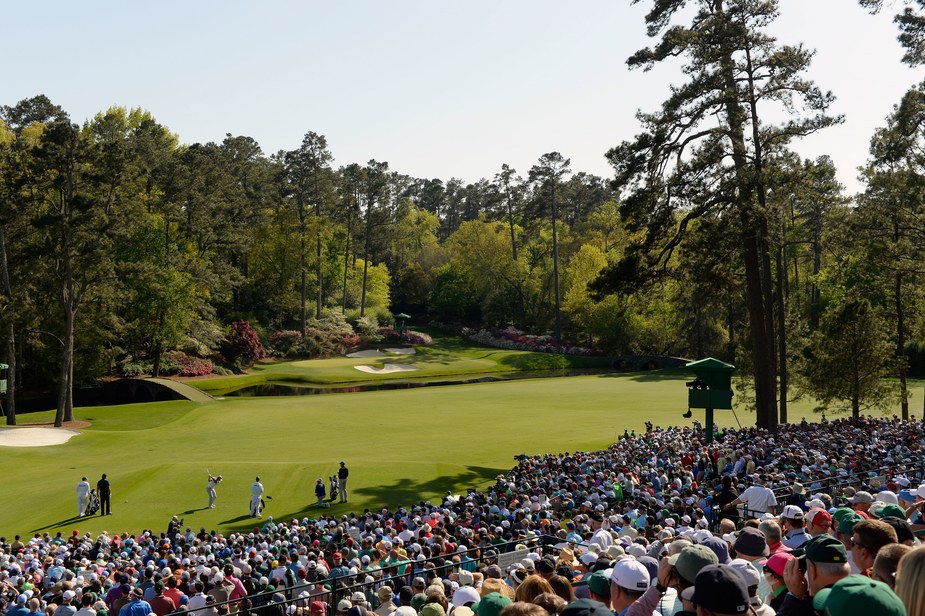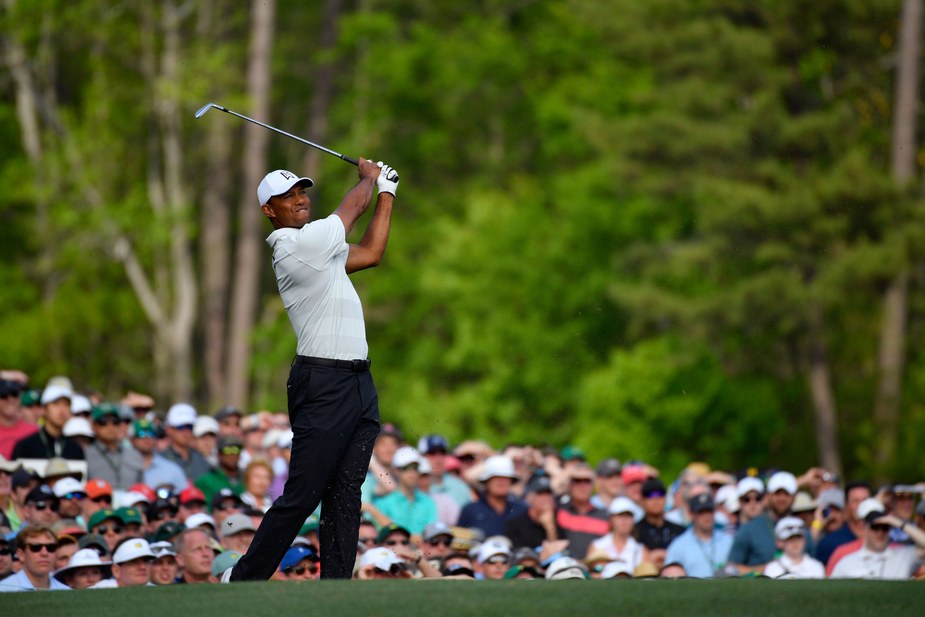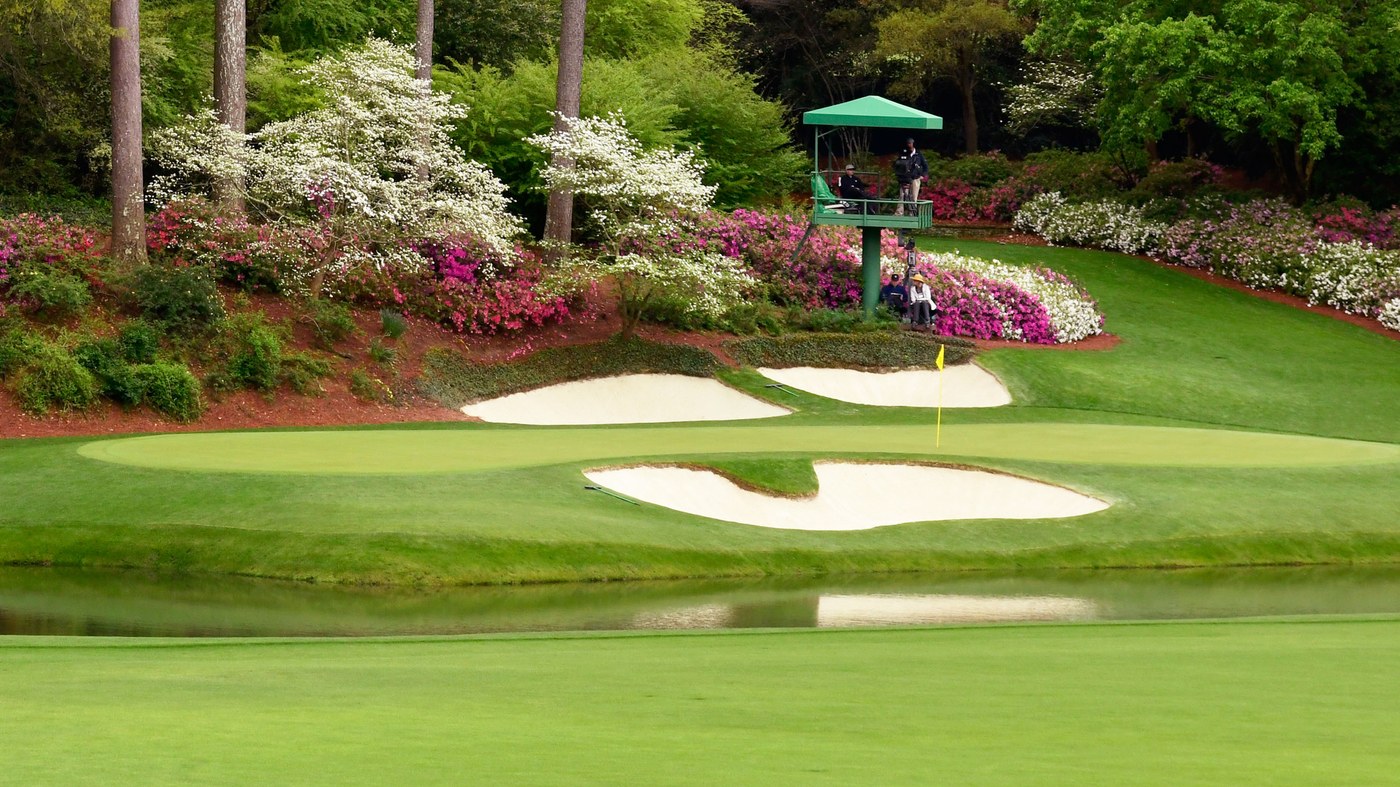Our writer spent the day at Augusta National’s 12th hole, where fans soak up the history and hope to see some in the making
By Brian Wacker
AUGUSTA, Ga. — Resplendent in her popping pinks, verdant greens and luminescent whites, she’s the prettiest girl in town, the captain of the cheerleading team with a smile that lights up the room.
Truth is, Golden Bell didn’t always look this way. In the 1950s, Augusta National’s 12th hole was tousled and unkempt, patchy grass and dirt fronting Rae’s Creek, a hideous yellow hazard line marking her bank and a garish chain-link fence behind, not an azalea in sight. Hell, the best par 3 in golf wasn’t even the 12th at the start. When the Augusta National Invitational Tournament began in 1934, the back nine was the front nine and vice versa, meaning the 155-yard gem was the third hole.
It was in that inaugural tournament that Bobby Jones became distracted by a cameraman, asked him to stop moving and promptly deposited his tee shot on the hole to its watery grave. By the time the club reopened in the fall of that year, the nines had been swapped, Clifford Roberts saying the change was made because play could begin earlier after a frost on what is the current front nine thanks to its higher elevation.
If the Masters has become a place to be seen, then the 12th, the middle hole in Herb Wind’s Amen Corner, has long been the place to see. “Let’s find a spot,” one spectator says in a southern accent as thick as marmalade, a green nylon folding chair over his shoulder and his elderly dad en tow. “This is god’s country.”
It is, indeed, a glorious Friday, midmorning, temperature in the upper 60s, a smattering of puffy white clouds against the blue sky, the green mostly covered in shade, the little yellow flag in the distance dancing in a gentle but swirling breeze. From the two grandstands that face the adjacent 11th green and angle toward the nearby 12th tee, it’s like looking at a painting. From the ground, it’s like living in one, feeling every slope beneath the feet and all those dastardly breezes the players must contend with in the air.

J.D. Cuban
The 12th tee flows up from the 11th green to its left, and the ever growing 13 tee is off in the distance to the right. Rae’s Creek looms dastardly in sight. Near the lowest point on the course, it all gives rise to one of the more perfect spots to spend an afternoon watching golf, or watching nothing at all.
Painted dark green lines on the grass outline an area to unload one of those dark green folding chairs, a few hundred or more already in place a couple dozen yards in front of the grandstands. Each has a business or note card with a name displayed in a clear plastic sleeve on the back. All but two feature the tournament’s logo. Little white signs with Masters green lettering designate it a “Sitting Area” with the words “No Smoking” beneath. Tranquility incarnate.
With the first group still more than an hour away, the chairs sit mostly empty. “It’s the only place you can put a chair down, leave for four hours and have it still be there when you come back,” one fan says. “That wouldn’t happen in New Jersey.” The grandstands are still only half-full, too. But a constant murmur from those milling about tells of something to come. God knows there have been so many somethings here.
Gene Sarazen hit two in the water here in 1952, made an 8 and withdrew. Arnold Palmer made triple in 1959 to hand the jacket to Art Wall Jr. Tom Weiskopf dumped five into the drink in 1980 en route to making a 13, the highest score recorded on the hole. Greg Norman had a triple on his way to blowing a six-shot lead to Nick Faldo in 1996.
In 2014, Jordan Spieth added his name to the dubious list. Playing his first Masters, he deposited one into the creek and went on to finish second to Bubba Watson. Two years later Spieth had another meltdown around Amen Corner, highlighted by a tee shot and a wedge from the drop zone both meeting a watery demise on 12 as he recorded a 7 in a moment that still haunts him.
Not all have met such death. Claude Harmon in 1947, Bill Hyndman in 1959 and Curtis Strange in 1988 all aced it. Fred Couples’ ball hanging on the bank in 1992 goes down as one of the great mysteries in all of physics. In 2003, Scott Verplank birdied it every day.
Michael Smith, a 59-year-old attorney from Atlanta, has seen nearly all of it. This year was his 35th or 40th Masters, so many he can’t remember which it is. A nice problem to have.
His first was in 1979, when Fuzzy Zoeller became only the third Masters rookie to win at Augusta National. But what Smith remembers from that year didn’t involve Zoeller or No. 12. He was left of the second hole, on an un-landscaped footpath through the woods, when he heard a ball rattling in the treetops and saw it land at his feet. It was off the club of Seve Bellesteros, of course.
“He had this six-foot gap 20 feet above him and he hit this perfect shot and birdied the hole,” says Smith, a 10-handicap who plays like a 5, according to the half dozen friends and family he’s entertaining this day.
Smith was also here in 1997. He followed Tiger Woods for the first nine holes of his first round. Disappointed by the opening 40, Smith abandoned him. “As soon as I left, he set records,” Smith says with a laugh.
Nearby is Billy Horschel’s dad, Bill, plopped down on one of those portable seats on the end of a metal rod you see so often at golf tournaments. His white hair flowing out from beneath a black PXG hat and a long, scraggly white beard covering much of his face, he munches on some carrots while waiting for his son, who is in the first group of the day, to come through. Prior to Billy’s first Masters, his dad joined him for a round and almost aced 16. Billy isn’t so fortunate on 12, going just right of the flag but long.
Si Woo Kim comes through a few groups later and, after a struggling bogey on 11, sticks one to 12 feet on 12. He missed the putt but the tee shot earned him hugs from two of the caddies in the group and gentle laughter from the gallery, including 61-year-old Randy Speir and his wife, Kathy, of New Jersey, who soak in the moment from the adjacent grandstand.
It’s Randy’s brother, who lives in nearby Florence, S.C., who was responsible for their badges. For years, he’d entered the tournament’s ticket lottery. Then one day a letter arrived saying he’d been placed into a different draw, one that he hit and included two lifetime badges.
“His name is Brant,” says Randy. “But I call him Lucky.”
Maybe, but it’s Kathy, a school teacher who’s on spring break for the week, whose roots in golf run deep. Her grandfather was a longtime member at Baltusrol and her 91-year-old mom still is. Golf’s a family thing. Kathy worked the U.S. Open there when Lee Janzen won in 1993 and when Jack Nicklaus did in 1980. This is Randy’s second Masters, but her first.
“It’s beautiful,” she said. “It’s very different than any other tournament I’ve been to.”
Beauty is in the eye of the beholder, though. Pretty as she is, No. 12 has a sinister side. With its difficult hole location and increasing breezes, it ranks as the third-toughest hole on the course, yielding just four birdies on this day, compared to 24 bogeys and seven doubles or worse.
One of them came from Woods. By the time he reached No. 12 late in the day he was long out of contention at three over for the round and a dozen strokes back. Still, the crowd swelled to the point of an L.A. traffic jam. He hoisted a short iron into the air. Splash for a second straight day.

J.D. Cuban
Tiger felt no love at the 12th during the first two rounds this year, hitting in the water off the tee both Thursday and Friday.
“Stuck in the ground again, trying to hit a flat cut,” he explained. “I leaned on it too much and got a little ahead of it.”
A not-so-golden moment.
“That hole, for whatever reason, just has people’s number,” Spieth said a couple of years ago.
But forever it’s the place to see, and the place to see so much, Amen.









